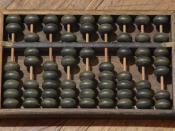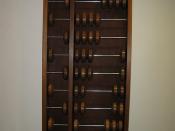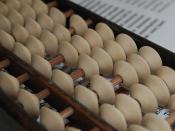The word Abacus is derived from the Greek "Abax" meaning counting board and the original types of Abacus were stone slates with dust covering them and a stylus used for marking numbers. Later this evolved into a slate with groves where rocks or other counters would be placed to mark numbers. Later it finally evolved into a framed device with beads sliding along bamboo rods. The abacus is thought to have appeared during circa 1200 A.D. in China; in Chinese, it is called the suan-pan. The classic Chinese abacus has two types of beads on the abacus, those in the lower deck, below the separator beam, and those in the upper deck above it. The ones in the lower deck are sometimes called earth beads, and carry a value of 1 in their column.
The ones in the upper deck are sometimes called heaven beads. Such an abacus is also referred to as a 2/5 style abacus.
The 2/5 style survived unchanged until about 1850 at which time the 1/5 one bead on the top deck and five beads on the bottom deck abacus appeared. The abacus can be used to ADD, SUBTRACT, MULTIPLY, and DIVIDE as well as work with sophisticated mathematical problems such as fractions and square root.
In Asian countries it is not unusual to see shopkeepers and street vendors using an abacus to calculate problems, especially where electricity is not convenient. Some elderly residents actually prefer the abacus over newer electronic devices. The calculations made on an abacus are immediate, with the device retaining the results which the user can see. Not only that some equation such as addition or subtraction are actually faster than normal calculators. In Asia parents still send their children to private tutors to learn bead arithmetic as a learning...


